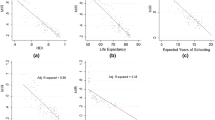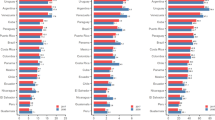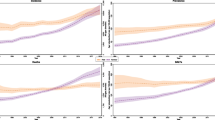Abstract
Purpose
This study aims to examine the burden of breast cancer in 185 countries in 2018.
Methods
The estimates of incidence, mortality, and prevalence of breast cancer were drawn from GLOBOCAN 2018. The overall burden of breast cancer was gauged using breast cancer burden index (BRCBI)—a novel index comprising age-standardized incidence rate (ASIR), age-standardized mortality rate (ASMR), mortality-to-incidence ratio (MIR), prevalence-to-incidence ratio (PIR), and prevalence-to-mortality ratio (PMR). The socioeconomic status of countries was measured using human development index (HDI)
Results
Globally, breast cancer was responsible for an estimated 626,679 deaths at age-standardized rate of 13/100,000; there were 2.1 million cases diagnosed in 2018 at age-standardized rate of 46.3/100,000. The ASIR varied 22-fold from 5/100,000 (Bhutan) to 113.2/100,000 (Belgium). The ASMR varied 13-fold from 2.7/100,000 (Bhutan) to 36.9/100,000 (Fiji). The HDI exhibited a positive gradient with ASIR (r = 0.73), PIR (r = 0.98), and PMR (r = 0.85); with MIR, however, it exhibited a negative association (r = − 0.83). The BRCBI spanned from 0.70 in Somalia to 78.92 in South Korea and exhibited a positive association with HDI (r = 0.76). An additional 46,823 female lives in 2018 and a cumulative total of 333,304 lives could have been saved over 2013–2018, had countries performed as per their HDI.
Conclusions
The substantial burden of breast cancer in developing and low-resource economies calls for a holistic approach to cancer management and control that includes oncologic infrastructure to provide cost-effective screening, diagnostic, therapeutic, and palliative services, greater breast cancer awareness, and mitigation of risk factors.




Similar content being viewed by others
Notes
Choosing minimum values as 1st percentile also helped in not assigning 0 value to BRCBI.
An alternate index using arithmetic mean was generated; it has a pairwise correlation of r = 0.9230 with BRCBI (Supplementary Table S3).
Number of deaths that could be prevented in 2018 was calculated as per the following.
$$({\text{Extra}}\; {\text{Deaths}})_{2018} = ({\text{Incidence}})_{2018}({\text{Observed}}\; {\text{MIR}}-{\text{Expected}}\; {\text{MIR}})$$Number of lives saved as per PMR was calculated as per the following.
$$\left( {{\text{Extra}}\; {\text{Deaths}}} \right)_{2013{-}18} = \left( {{\text{Observed}} \;{\text{Deaths}}} \right)_{2018} \left( {{\text{Observed}}\; {\text{PMR }}- {\text{Expected}}\; {\text{PMR}}} \right)$$
References
Global Burden of Disease Cancer Collaboration (2019) Global, Regional, and National Cancer Incidence, Mortality, Years of Life Lost, Years Lived With Disability, and Disability-Adjusted Life-Years for 29 Cancer Groups, 1990 to 2017: a systematic analysis for the global burden of disease study. JAMA Oncol 5(12):1749–1768. https://doi.org/10.1001/jamaoncol.2019.2996
Allemani C, Matsuda T, Di Carlo V et al (2018) Global surveillance of trends in cancer survival 2000–14 (CONCORD-3): analysis of individual records for 37 513 025 patients diagnosed with one of 18 cancers from 322 population-based registries in 71 countries. Lancet 391(10125):1023–1075
Sharma R (2019) Breast cancer incidence, mortality and mortality-to-incidence ratio (MIR) are associated with human development, 1990–2016: evidence from Global Burden of Disease Study 2016. Breast Cancer 26(4):428–445
Pérez-Solis MA, Maya-Nuñez G, Casas-González P et al (2016) Effects of the lifestyle habits in breast cancer transcriptional regulation. Cancer Cell Int 16(1):7
Yung RL, Ligibel JA (2016) Obesity and breast cancer: risk, outcomes, and future considerations. Clin Adv Hematol Oncol 14(10):790–797
Bradbury AR, Olopade OI (2007) Genetic susceptibility to breast cancer. Rev Endocr Metab Disord 8(3):255–267
Kim H, Choi DH (2013) Distribution of BRCA1 and BRCA2 mutations in Asian patients with breast cancer. J Breast Cancer 16(4):357–365
Skol AD, Sasaki MM, Onel K (2016) The genetics of breast cancer risk in the post-genome era: thoughts on study design to move past BRCA and towards clinical relevance. Breast Cancer Res 18(1):99
Bray F, Ferlay J, Soerjomataram I et al (2018) Global cancer statistics 2018: GLOBOCAN estimates of incidence and mortality worldwide for 36 cancers in 185 countries. CA Cancer J Clin 68(6):394–424
Ferlay J, Colombet M, Soerjomataram I et al (2019) Estimating the global cancer incidence and mortality in 2018: GLOBOCAN sources and methods. Int J Cancer 144(8):1941–1953
UNDP. Human Development Statistical Update 2018. (United nations Development Programme,2016) http://hdr.undp.org/sites/default/files/2018_human_development_statistical_update.pdf. Accessed 24 June2019
Vostakolaei F, Karim-Kos HE, Janssen-Heijnen ML et al (2010) The validity of the mortality to incidence ratio as a proxy for site-specific cancer survival. Eur J Public Health 21(5):573–577
Choi E, Lee S, Nhung BC et al (2017) Cancer mortality-to-incidence ratio as an indicator of cancer management outcomes in Organization for Economic Cooperation and Development countries. Epidemiol Health 39:e2017006
Sharma R (2019) The burden of prostate cancer is associated with human development index: evidence from 87 countries, 1990–2016. EPMA J 10(2):137–152
Ferlay J, Ervik M, Lam F et al Global Cancer Observatory. Lyon, France: International Agency for Research on Cancer. https://gco.iarc.fr/. Accessed Dec 2019 - Jan 2020
Human Development Database. http://hdr.undp.org/en/data#. Accessed Dec 2019
Brinton LA, Figueroa JD, Awuah B et al (2014) Breast cancer in Sub-Saharan Africa: opportunities for prevention. Breast Cancer Res Treat 144(3):467–478
Sharma R (2020) Breast cancer burden in Africa: evidence from GLOBOCAN 2018. J Public Health. https://doi.org/10.1093/pubmed/fdaa099
DeSantis CE, Ma J, Goding Sauer A et al (2017) Breast cancer statistics, racial disparity in mortality by state. CA Cancer J Clin 67(6):439–448
Gabriel CA, Domchek SM (2010) Breast cancer in young women. Breast Cancer Res 12(5):212
Corbex M, Bouzbid S, Boffetta P (2014) Features of breast cancer in developing countries, examples from North-Africa. Eur J Cancer 50(10):1808–1818
Youlden DR, Cramb SM, Yip CH, Baade PD (2014) Incidence and mortality of female breast cancer in the Asia-Pacific region. Cancer Boil Med 11(2):101
Youlden DR, Cramb SM, Dunn NA et al (2012) The descriptive epidemiology of female breast cancer: an international comparison of screening, incidence, survival and mortality. Cancer Epidemiol 36(3):237–248
Shapiro S (1997) Periodic screening for breast cancer: the HIP randomized controlled trial. JNCI Monogr 1997(22):27–30
Tabár L, Yen AM, Wu WY et al (2015) Insights from the breast cancer screening trials: how screening affects the natural history of breast cancer and implications for evaluating service screening programs. Breast J 21(1):13–20
Bleyer A, Welch HG (2012) Effect of three decades of screening mammography on breast-cancer incidence. N Engl J Med 367(21):1998–2005
Marmot MG, Altman DG, Cameron DA et al (2013) The benefits and harms of breast cancer screening: an independent review. Br J Cancer 108(11):2205–2240
Harford JB (2011) Breast-cancer early detection in low-income and middle-income countries: do what you can versus one size fits all. Lancet Oncol 12(3):306–312
Black E, Richmond R (2019) Improving early detection of breast cancer in sub-Saharan Africa: why mammography may not be the way forward. Glob Health 15(1):3
dos-Santos-Silva I, de Stavola BL, Junior NL, Nogueira MC, Aquino EM, Bustamante-Teixeira MT, Silva GA (2019) Ethnoracial and social trends in breast cancer staging at diagnosis in Brazil, 2001–14: a case only analysis. Lancet Glob Health 7(6):e784–e797
Mittra I, Mishra GA, Singh S et al (2010) A cluster randomized, controlled trial of breast and cervix cancer screening in Mumbai, India: methodology and interim results after three rounds of screening. Int J Cancer 126(4):976–984
Sankaranarayanan R, Ramadas K, Thara S et al (2011) Clinical breast examination: Preliminary results from a cluster randomized controlled trial in India. J Natl Cancer Inst 103(19):1476–1480
Abuidris DO, Elsheikh A, Ali M et al (2013) Breast-cancer screening with trained volunteers in a rural area of Sudan: a pilot study. Lancet Oncol 14(4):363–370
Song QK, Wang XL, Zhou XN et al (2015) Breast cancer challenges and screening in China: Lessons from current registry data and population screening studies. Oncologist 20(7):773–779
Sankaranarayanan R, Swaminathan R, Brenner H et al (2010) Cancer survival in Africa, Asia, and Central America: a population-based study. Lancet Oncol 11(2):165–173
Jedy-Agba E, McCormack V, Adebamowo C et al (2016) Stage at diagnosis of breast cancer in sub-Saharan Africa: a systematic review and meta-analysis. Lancet Glob Health 4(12):e923–e935
Abdulrahman GO, Rahman GA (2012) Epidemiology of breast cancer in Europe and Africa. J Cancer Epidemiol 2012:915610
Sariego J (2009) Patterns of breast cancer presentation in the United States: does geography matter? Am Surg 75(7):545–550
Akuoko CP, Armah E, Sarpong T, Quansah DY, Amankwaa I, Boateng D (2017) Barriers to early presentation and diagnosis of breast cancer among African women living in sub-Saharan Africa. PLoS ONE 12(2):e0171024
Tetteh DA, Faulkner SL (2016) Sociocultural factors and breast cancer in sub-Saharan Africa: implications for diagnosis and management. Women’s Health 12(1):147–156
Yip CH (2019) Downstaging is more important than screening for asymptomatic breast cancer. Lancet Glob Health 7(6):e690–e691
McCormack V, McKenzie F, Foerster M, Zietsman A, Galukande M, Adisa C, Anele A, Parham G, Pinder LF, Cubasch H, Joffe M (2020) Breast cancer survival and survival gap apportionment in sub-Saharan Africa (ABC-DO): a prospective cohort study. Lancet Glob Health 8(9):e1203–e1212
Devi BC, Tang TS, Corbex M (2007) Reducing by half the percentage of late-stage presentation for breast and cervix cancer over 4 years: a pilot study of clinical downstaging in Sarawak. Malays Ann Oncol 18(7):1172–1176
Foerster M, Anderson BO, McKenzie F, Galukande M, Anele A, Adisa C, Zietsman A, Schuz J, dos Santos SI, McCormack V (2019) Inequities in breast cancer treatment in sub-Saharan Africa: findings from a prospective multi-country observational study. Breast Cancer Res 21(1):93
Clegg-Lamptey J, Dakubo J, Attobra YN (2009) Why do breast cancer patients report late or abscond during treatment in ghana? A pilot study. Ghana Med J 43(3):127–131
Sullivan R, Alatise OI, Anderson BO (2015) Global cancer surgery: delivering safe, affordable, and timely cancer surgery. Lancet Oncol 16(11):1193–1224
Porter P (2008) ‘Westernising’ women’s risks? Breast cancer in lower income countries. N Engl J Med 358(3):213–216
Author information
Authors and Affiliations
Corresponding author
Ethics declarations
Conflicts of interest
The authors declare that they have no conflict of interest.
Informed consent
Human and animal rights
This article does not contain any studies with human participants or animals performed by any of the authors.
Informed consent
The research was conducted using data available in the public domain and did not include any human participants or animals.
Additional information
Publisher's Note
Springer Nature remains neutral with regard to jurisdictional claims in published maps and institutional affiliations.
Supplementary Information
Below is the link to the electronic supplementary material.
Rights and permissions
About this article
Cite this article
Sharma, R. Global, regional, national burden of breast cancer in 185 countries: evidence from GLOBOCAN 2018. Breast Cancer Res Treat 187, 557–567 (2021). https://doi.org/10.1007/s10549-020-06083-6
Received:
Accepted:
Published:
Issue Date:
DOI: https://doi.org/10.1007/s10549-020-06083-6




